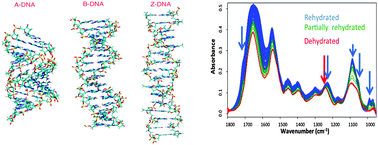The importance of hydration and DNA conformation in interpreting infrared spectra of cells and tissues
Abstract
Since Watson and Crick's historical papers on the structure and function of DNA based on Rosalind Franklin's and Maurice Wilkin's X-ray diffraction patterns tremendous scientific curiosity has been aroused by the unique and dynamic structure of the molecule of life. A-DNA and B-DNA represent different conformations of the DNA molecule, which is stabilised by hydrogen interactions between base pairs, stacking interactions between neighboring bases and long-range intra- and inter-backbone forces. This review highlights the contribution Fourier transform infrared (FTIR) spectroscopy has made to the understanding of DNA conformation in relation to hydration and its potential role in clinical diagnostics. The review will first begin by elucidating the main forms of DNA conformation found in nature and the general structures of the A, B and Z forms. This is followed by a detailed critique on infrared spectroscopy applied to DNA conformation highlighting pivotal studies on isolated DNA, polynucleotides, nucleoprotein and nucleohistone complexes. A discussion on the potential of diagnosing cancer using FTIR spectroscopy based on the detection of DNA bands in cells and tissues will ensue, highlighting the recent studies investigating the conformation of DNA in hydrated and dehydrated cells. The method of hydration as a way to facilitate DNA conformational band assignment will be discussed and the conformational change to the A-form upon dehydration will be used to explain the reason for the apparent lack of FTIR DNA signals observed in fixed or air-dried cells and tissues. The advantages of investigating B-DNA in the hydrated state, as opposed to A-DNA in the dehydrated state, are exemplified in a series of studies that show: (1) improved quantification of DNA in cells; (2) improved discrimination and reproducibility of FTIR spectra recorded of cells progressing through the cell cycle; (3) insights into the biological significance of A-DNA as evidenced by an interesting study on bacteria, which can survive desiccation and at the same time undergo the B–A–B transition. Finally, the importance of preserving the B-DNA conformation for the diagnosis of cancer is put forward as way to improve the sensitivity of this powerful technique.

- This article is part of the themed collection: Fundamental Developments in Clinical Infrared and Raman Spectroscopy

 Please wait while we load your content...
Please wait while we load your content...